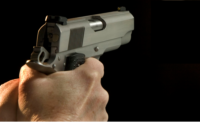In a study done by the FBI in 2014, it was found that most active shootings end in 2 minutes or less. That’s not enough time for law enforcement to arrive. So when you start hearing gunshots in places you shouldn’t be hearing gunshots, you don’t have much time to think about what you should do.
When any emergency strikes, be it an active shooter or a fire, the natural response for most people, surprisingly, is not to do anything. Our brain is predisposed to assume that things will carry on in a predictable way. When the pattern is broken, it takes a long time for the brain to process this aberration.
Another bias that freezes us is our natural tendency to follow the crowd. If we see that everyone else is cowering in fear or locked up by inertia, then our natural tendency is to act the same.
Visualize what you would do in various situations were an active shooter to suddenly intrude upon the scene. What would your plan be if you were in the office and heard shots coming from the floor beneath you? Would you have time to run? If so, where would you go? If you heard the shots just down the hallway and there’s no place to run or hide, what would be your next step? Visualize your plan in as much detail as possible.
In addition to having a general idea of what you’d do in an active shooter situation, you must constantly maintaining situational awareness.
Stay in condition yellow. Condition Yellow is best described as “relaxed alert.” There’s no specific threat situation, but you have your head up and you’re taking in your surroundings with all your senses. Though your senses are slightly heightened in Condition Yellow, it’s also important to stay relaxed. Staying relaxed ensures that you maintain an open focus, which allows you to take in more information about what’s going on around you. Research shows that when we get nervous or stressed, our attention narrows, causing us to concentrate on just a few things at a time. A narrow focus can therefore cause us to miss important details in our environment.
As Patrick Van Horne notes in his book “Left of Bang,” a key element of situational awareness is establishing baselines and looking for anomalies. A baseline is what’s “normal” in a given situation, and it will differ from person to person and environment to environment. We establish baselines so that we can look for anomalies. Hearing gunshots at a college campus is definitely out of the ordinary, and should immediately trigger your active shooter plan of action.
Source: Brett and Kate McKay, The Art of Manliness, www.artofmanliness.com


